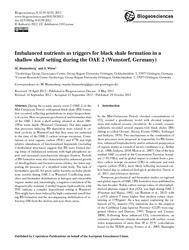Imbalanced nutrients as triggers for black shale formation in a shallow shelf setting during the OAE 2 (Wunstorf, Germany)
Blumenberg, M.
Wiese, F.
9, 10: 4139 - 4153
DOI: https://doi.org/10.5194/bg-9-4139-2012
Persistent URL: http://resolver.sub.uni-goettingen.de/purl?gldocs-11858/6579
Persistent URL: http://resolver.sub.uni-goettingen.de/purl?gldocs-11858/6579
Blumenberg, M.; Wiese, F., 2012: Imbalanced nutrients as triggers for black shale formation in a shallow shelf setting during the OAE 2 (Wunstorf, Germany). In: Biogeosciences, Band 9, 10: 4139 - 4153, DOI: 10.5194/bg-9-4139-2012.
 |
Dokument öffnen: |
During the oceanic anoxic event 2 (OAE 2) in the
Mid-Cretaceous Period, widespread black shale (BS) formation
occurred, reflecting perturbations in major biogeochemical
cycles. Here we present geochemical and biomarker data
of the OAE 2 from a shelf setting situated at about 100–
150m water depth (Wunstorf, Germany). Our data support
that processes inducing BS deposition were related to orbital
cyclicity in Wunstorf and that they were not restricted
to the time of the OAE 2 carbon isotope excursion. Correlations
of total organic carbon (TOC) and 15N and high
relative abundances of functionalized hopanoids (including
2-methylated structures) suggest that BS were formed during
times of imbalanced nutrients with high phosphorus inputs
and increased cyanobacterial nitrogen fixation. Periods
of BS formation were also characterized by enhanced growth
of dinoflagellates and bacteriovorous ciliates, the latter supporting
the presence of a stratified water body. The lack of
biomarkers specific for green sulfur bacteria excludes photic
zone euxinia during OAE 2 in Wunstorf. Conflicting maturities
and biomarker distributions in kerogen and extractable
organic matter and, interestingly, a negative correlation of the
diagenetically resistant 2-methyl hopane hydrocarbons with
TOC indicate a complex depositional setting at Wunstorf.
This might have been induced by high continental runoff during
BS formation and the accompanying mobilisation of refractory
OM from the shelves and near shore areas.
Statistik:
ZugriffsstatistikSammlung:
- Geologie [933]


